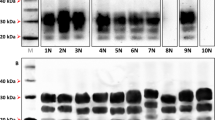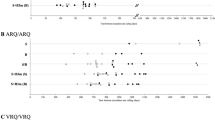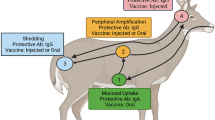Abstract
This study examines the effect of various infectious prion titers within the dynamic range as measured by ELISA on incubation period. We inoculated ovinized transgenic mice with seven decreasing dilutions of a fast-incubating scrapie strain. The highest inoculum group was a 20% w/v brain homogenate from a sheep with scrapie. The subsequent six inoculum dilutions ranged from the highest ELISA optical density reading of 4.000 to a dilution where scrapie prions were not detectable by ELISA. Multiple comparison analysis demonstrated variation in the incubation periods between some inoculum groups. Incubation periods were similar between inoculum groups unless their optical density differed by more than ≈2 units of absorbance. These data will inform the interpretation of future studies that compare incubation periods in experimentally inoculated animals for TSE research.
Similar content being viewed by others
Avoid common mistakes on your manuscript.
Short communication
Transmissible spongiform encephalopathies (TSEs), also referred to as prion diseases, are a group of fatal neurodegenerative diseases caused by a misfolded form (designated as PrPSc) of the prion protein (Prusiner 1998). There are several species-specific TSEs affecting non-human animals including scrapie in sheep and goats (Prusiner 1998), bovine spongiform encephalopathy (mad cow disease) in cattle (Wells et al. 1987), and chronic wasting disease in cervids (Williams and Young 1992). Due to the protracted incubation period of TSEs in their natural hosts, experiments are frequently carried-out in mouse models.
The incubation period of TSEs is influenced by host-recipient genetics, TSE strain, age, and infectious dose (Bruce 2003; Ryder et al. 2009). A meta-analysis of 117 dose titration studies compared the relationship between infectious dose and incubation period in mice (McLean and Bostock 2000). The studies applied broad log10 dose- titrations to examine variability in incubation periods. The authors of the meta-analysis observed that incubation period increases linearly relative to a logarithmic decrease in dose, and incubation period variability is greater at lower doses.
Enzyme linked immunoassays (ELISAs) are frequently used to confirm a TSE diagnosis. In the present study, we sought to determine the variability in incubation period relative to doses within the dynamic range of ELISA absorbances. In the context of this assay, the dynamic range was defined as the range of dilutions extending from the lowest point on curve to the highest (4.000 OD). The results shed light on how the dose titer of infectious prions within the dynamic range of ELISA absorbances influences incubation period, and will assist in the comparison of incubation periods of inoculated animals for future TSE research.
To determine the necessary dilutions to obtain optical densities between 4.0 (max absorbance) and undetectable scrapie prions, we used a 20% w/v brain homogenate from a Suffolk sheep (VRQ/VRQ) that had been inoculated with the brain pool homogenate from the ×124 fast incubating scrapie strain (Bulgin et al. 2006; Hamir et al. 2009; Moore et al. 2016) to perform a series of dilutions. The stock brain homogenate had an OD of 4.000 and was considered to have quantities of PrPSc vastly greater than what would be expected for a maximum prion concentration to achieve an OD of 4.000. Therefore, we initially started with a 32x dilution and proceeded with a 2x dilution series until the optical density dropped below 4.000. All dilutions were made with phosphate buffered saline. The last dilution to result as a 4.000 optical density (128x) was considered a true 4.000 reading. Subsequent dilutions corresponded closely with whole number optical densities until the final dilution resulted in non-detectable PrPSc (Table 1 and Fig. 1).
Determination of the ELISA dynamic range for the inocula. (A) Optical density on the y-axis plotted against a 2-fold dilution series ranging from 4096x (1/4096 = 0.000244) to 128x (1/128 = 0.00781) left-to-right. (B) Log transformed 2-fold dilutions corresponding to 4096x, 2048x, 1024x, 512x, 256x, 128x, 64x, 32x, and 20% w/v homogenate compared to optical density on the y-axis left-to-right
To examine the variation in incubation periods between different ELISA optical densities, we intracranially inoculated 20 uL of brain homogenate into cohorts of ovinized transgenic (Tg338) mice (Vilotte et al. 2001) based on the different sample dilutions. Seven groups of mice were inoculated with either the stock homogenate (undiluted, denoted 1x) 20% w/v, 128-, 256-, 512-, 1024-, 2048-, or 4096-fold dilutions. Mice were monitored daily for clinical signs associated with prion disease in mice including poor hygiene/haircoat, ataxia, circling, or inability to right position. Upon observation of clinical signs, mice were humanely euthanized, and brains were collected for ELISA (HerdChek; IDEXX Laboratories, Westbrook, ME) to confirm prion disease. Mice that died prior to observation of clinical signs were not used to calculate the incubation period even though they were ELISA positive for prion disease; this was to ensure an accurate measurement of time between inoculation and clinical disease onset (incubation period). The final data set included 12, 13, 13, 15, 17, 16 and 14 mice from each group, respectively. The mean incubation periods corresponding to each inoculum group were 66.5, 88.9, 90.5, 94.7, 102.4, 102.5, and 106.3 days (Table 1).
To assess differences between incubation periods in each inoculum group, we performed Brown-Forsythe and Welch ANOVA tests followed by Dunnett’s T3 multiple comparisons test using GraphPad Prism version 9.3.1 for Windows, GraphPad Software, San Diego, California USA, www.graphpad.com (Fig. 2). The results of the ANOVA tests showed a significant difference between groups (p < 0.0001). For multiple comparisons, the greatest differences in incubation periods were noted between the 20% w/v inoculum group (1x) and all other optical density adjusted dilutions (p < 0.0001). Differences in the incubation period were not significantly different for seven optical densities comparisons: 4.0 vs. 3.342, 4.0 vs. 2.088, 3.342 vs. 2.088, 2.088 vs. 0.880, 0.880 vs. 0.237, 0.880 vs. 0.063, and 0.237 vs. 0.063 (Fig. 2B).
Comparison of ELISA adjusted samples to incubation period. (A) Mean incubation period in days on the y-axis plotted against the dilution group and corresponding optical density (error bars indicate standard deviation). (B) Results from Dunnett’s T3 multiple comparisons analysis. Error bars overlapping zero difference between group means indicates no significant difference between groups (α = 0.95)
Our results demonstrate that prion titers within the measurable optical density range influence the incubation period in our model. However, differences in incubation period are less substantial and frequently insignificant when both optical densities are above or below ≈2.000. For example, the difference in incubation periods between 3.342 and 2.088 was not statistically significant, but the difference between 3.342 and 0.880 was significant. This caveat does not hold true for samples with 4.000 values exceeding the maximum absorbance reading of 4.000. The titer of infectious prions in a 20% w/v brain homogenate was 128-fold above the maximum ELISA absorbance, and inoculation of mice resulted in a significantly shorter incubation period compared to an optical density of 4.000 where it drops into the dynamic absorbance range. An interesting observation was that mice inoculated with the ELISA negative 4096x dilution had similar incubation periods to positive ELISA optical densities of 0.880 and 0.237. This is not a novel discovery; instead, it simply underscores the superior sensitivity of mouse bioassays and cautions interpretation of ELISA results as negative. A better designation for non-positive ELISA results is non-detectable. Given that previous mouse studies of prion titers demonstrated differences in attack rates and incubation periods after several logarithmic dilutions of sample (Andreoletti et al. 2011; Douet et al. 2014; McLean and Bostock 2000), we did not expect there to be a significant difference in incubation periods within the measurable range of ELISA optical densities that corresponded to 128-fold to 4096-fold dilutions. However, results from this study suggest that differences greater than ≈2 units of absorbance within the ELISA measurable range and large titers exceeding the maximum OD of 4.000 can significantly influence the incubation period in mice. These findings will assist in the comparison of incubation periods of inoculated animals for future TSE research.
Data availability
The datasets generated during and/or analyzed during the current study are available from the corresponding author on reasonable request.
References
Andreoletti O, Orge L, Benestad SL, Beringue V, Litaise C, Simon S, Le Dur A, Laude H, Simmons H, Lugan S, Corbiere F, Costes P, Morel N, Schelcher F, Lacroux C (2011) Atypical/Nor98 scrapie infectivity in sheep peripheral tissues. PLoS Pathog 7(2):e1001285. https://doi.org/10.1371/journal.ppat.1001285
Bruce ME (2003) TSE strain variation. Br Med Bull 66:99–108
Bulgin MS, Sorensen SJ, Matlock ME (2006) Association between incubation time and genotype in sheep experimentaslly inoculated with scrapie-positive brain homogenate. AJVR 67(3):7
Douet JY, Lacroux C, Corbiere F, Litaise C, Simmons H, Lugan S, Costes P, Cassard H, Weisbecker JL, Schelcher F, Andreoletti O (2014) PrP expression level and sensitivity to prion infection. J Virol 88(10):5870–5872. https://doi.org/10.1128/JVI.00369-14
Hamir AN, Richt JA, Kunkle RA, Greenlee JJ, Bulgin MS, Gregori L, Rohwer RG (2009) Characterization of a US sheep scrapie isolate with short incubation time. Vet Pathol 46(6):1205–1212. https://doi.org/10.1354/vp.08-VP-0258-H-FL
McLean AR, Bostock CJ (2000) Scrapie infections initiated at varying doses: an analysis of 117 titration experiments. Philos Trans R Soc Lond Ser B Biol Sci 355(1400):1043–1050. https://doi.org/10.1098/rstb.2000.0641
Moore SJ, Smith JD, Greenlee MHW, Nicholson EM, Richt JA, Greenlee JJ (2016) Comparison of two us sheep scrapie isolates supports identification as separate strains. Vet Pathol 53(6):1187–1196. https://doi.org/10.1177/0300985816629712
Prusiner SB (1998) Prions. Proc Natl Acad Sci U S A 95(23):13363–13383
Ryder SJ, Dexter GE, Heasman L, Warner R, Moore SJ (2009) Accumulation and dissemination of prion protein in experimental sheep scrapie in the natural host. BMC Vet Res 5:9. https://doi.org/10.1186/1746-6148-5-9
Vilotte JL, Soulier S, Essalmani R, Stinnakre MG, Vaiman D, Lepourry L, Da Silva JC, Besnard N, Dawson M, Buschmann A, Groschup M, Petit S, Madelaine MF, Rakatobe S, Le Dur A, Vilette D, Laude H (2001) Markedly increased susceptibility to natural sheep scrapie of transgenic mice expressing ovine prp. J Virol 75(13):5977–5984. https://doi.org/10.1128/JVI.75.13.5977-5984.2001
Wells GA, Scott AC, Johnson CT, Gunning RF, Hancock RD, Jeffrey M, Dawson M, Bradley R (1987) A novel progressive spongiform encephalopathy in cattle. Vet Rec 121(18):419–420
Williams ES, Young S (1992) Spongiform encephalopathies in Cervidae. Revue scientifique et technique (Int Off Epizootics) 11(2):551–567
Acknowledgements
We thank Kevin Hassall and Leisa Mandell for providing excellent technical support to this project and Hubert Laude for providing Tg338 mice. Mention of trade names or commercial products in this article is solely for the purpose of providing specific information and does not imply recommendation or endorsement by the Department of Agriculture. The Department of Agriculture is an equal-opportunity provider and employer.
Funding
This research was funded in its entirety by congressionally appropriated funds to the United States Department of Agriculture, Agricultural Research Service. The funders of the work did not influence study design, data collection and analysis, decision to publish, or preparation of the manuscript. This research was supported in part by an appointment to the Agricultural Research Service (ARS) Research Participation Program administered by the Oak Ridge Institute for Science and Education (ORISE) through an interagency agreement between the U.S. Department of Energy (DOE) and the U.S. Department of Agriculture (USDA). ORISE is managed by ORAU under DOE contract number DE-SC0014664. All opinions expressed in this paper are the author’s and do not necessarily reflect the policies and views of USDA, ARS, DOE, or ORAU/ORISE.
Author information
Authors and Affiliations
Contributions
Conceptualization, E.D.C., J.J.G, and H.W.G; Study design, E.D.C; validation, E.D.C.; methodology, E.D.C.; validation, J.J.G. and E.D.C.; formal analysis, E.D.C.; investigation, E.D.C., Z.J.L, A.J.F, and Q.L.B; resources, E.D.C. and J.J.G; writing—original draft preparation, E.D.C.; writing—review and editing, E.D.C., J.J.G, H.W.G, Z.J.L, A.J.F, and Q.L.B; supervision, E.D.C. All authors have read and agreed to the published version of the manuscript.
Corresponding author
Ethics declarations
Ethics approval
The laboratory and animal experiments were conducted in Biosafety Level 2 spaces that were inspected and approved for importing prion agents by the US Department of Agriculture, Animal and Plant Health Inspection Service, Veterinary Services. The studies were done in accordance with the Guide for the Care and Use of Laboratory Animals (Institute of Laboratory Animal Resources, National Academy of Sciences, Washington, DC, USA). The protocols were approved by the Institutional Animal Care and Use Committee at the National Animal Disease Center (protocol numbers: ARS-2020-895 and ARS-2020-858), which requires species-specific training in animal care for all staff handling animals.
Competing interests
The authors have no relevant financial or non-financial interests to disclose.
Additional information
Publisher’s note
Springer Nature remains neutral with regard to jurisdictional claims in published maps and institutional affiliations.
Rights and permissions
Open Access This article is licensed under a Creative Commons Attribution 4.0 International License, which permits use, sharing, adaptation, distribution and reproduction in any medium or format, as long as you give appropriate credit to the original author(s) and the source, provide a link to the Creative Commons licence, and indicate if changes were made. The images or other third party material in this article are included in the article's Creative Commons licence, unless indicated otherwise in a credit line to the material. If material is not included in the article's Creative Commons licence and your intended use is not permitted by statutory regulation or exceeds the permitted use, you will need to obtain permission directly from the copyright holder. To view a copy of this licence, visit http://creativecommons.org/licenses/by/4.0/.
About this article
Cite this article
Cassmann, E.D., Brown, Q.L., Frese, A.J. et al. Effect of inoculation with prion dilutions within the dynamic range of ELISA absorbance on prion incubation period. Vet Res Commun 46, 1377–1380 (2022). https://doi.org/10.1007/s11259-022-10013-w
Received:
Accepted:
Published:
Issue Date:
DOI: https://doi.org/10.1007/s11259-022-10013-w






